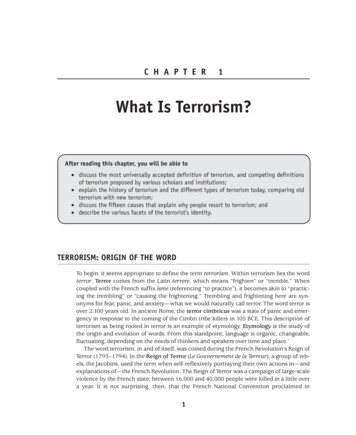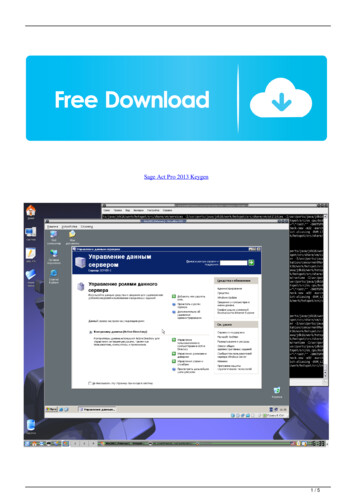
Transcription
C H A P T E R1What Is Terrorism?After reading this chapter, you will be able to discuss the most universally accepted definition of terrorism, and competing definitionsof terrorism proposed by various scholars and institutions; explain the history of terrorism and the different types of terrorism today, comparing oldterrorism with new terrorism; discuss the fifteen causes that explain why people resort to terrorism; and describe the various facets of the terrorist’s identity.TERRORISM: ORIGIN OF THE WORDTo begin, it seems appropriate to define the term terrorism. Within terrorism lies the wordterror. Terror comes from the Latin terrere, which means “frighten” or “tremble.” Whencoupled with the French suffix isme (referencing “to practice”), it becomes akin to “practicing the trembling” or “causing the frightening.” Trembling and frightening here are synonyms for fear, panic, and anxiety—what we would naturally call terror. The word terror isover 2,100 years old. In ancient Rome, the terror cimbricus was a state of panic and emergency in response to the coming of the Cimbri tribe killers in 105 BCE. This description ofterrorism as being rooted in terror is an example of etymology. Etymology is the study ofthe origin and evolution of words. From this standpoint, language is organic, changeable,fluctuating, depending on the needs of thinkers and speakers over time and place.1The word terrorism, in and of itself, was coined during the French Revolution’s Reign ofTerror (1793–1794). In the Reign of Terror (Le Gouvernement de la Terreur), a group of rebels, the Jacobins, used the term when self-reflexively portraying their own actions in—andexplanations of—the French Revolution. The Reign of Terror was a campaign of large-scaleviolence by the French state; between 16,000 and 40,000 people were killed in a little overa year. It is not surprising, then, that the French National Convention proclaimed in1
2TERRORISM AND COMMUNICATIONSeptember 1793 that “terror is the order of the day.” Maximilien Robespierre, a frontrunnerin the French Revolution, declared in 1794 that “terror is nothing other than justice,prompt, severe, inflexible.” The very first official definition of terrorism in French wasprovided several years later. In 1798, the French released the supplement for the dictionaryof the Académie Française, an elite French learned body on matters dealing with theFrench language. In this supplement, the term was explained as the “système, régime de laterreur” (i.e., “government of terror”). The English version of the word terrorism is attributed to a British man’s depiction of the bloodshed he had witnessed from afar in France,where the revolution was happening. Sir Edmund Burke commented on the FrenchRevolution and warned about “thousands of those hell hounds called terrorists.”2TERRORISM: DEFINITIONWhile the Reign of Terror was a product of the French government, in modern times, terrorism denotes the killing of humans by nongovernment political actors for variousreasons—usually as a political statement. This interpretation came from Russian radicalsin the 1870s. Sergey Nechayev, the founder of People’s Retribution in 1869, viewed himselfas a terrorist. In the 1880s, German anarchist writer Johann Most helped promote the modern gist of the word by giving out “advice for terrorists.”3 Worldwide, many governmentsare incredibly averse to defining terrorism because they are worried about how an officialdefinition of terrorism would expose the legitimacy of self-proclaimed combats of nationalliberation. In certain countries, the word has become virtually synonymous with politicalopponents. For instance, the Chinese call pacific Tibetan Buddhists vicious terrorists. InZimbabwe, President Robert Mugabe regards the democratic opposition in a similar fashion.4 Terrorism is a pejorative term. When people employ the term, they characterize theirenemies’ actions as something evil and lacking human compassion. Terrorism is considered worse than war, torture, or murder. A pejorative term is a term that is fraught withnegative and derogatory meanings.5Studies have found more than 200 definitions of terrorism. In fact, Simon (1994)6reports that at least 212 different definitions of terrorism exist across the world; 90 of themare recurrently used by governments and other institutions. Schmid and Jongman (1988),7two researchers at the University of Leiden (Netherlands), adopted a social science approachto figure out how to best define terrorism. They gathered over a hundred academic andofficial definitions of terrorism and examined them to identify the main components. Theydiscovered that the concept of violence emerged in 83.5% of definitions; political goalsemerged in 65%; causing fear and terror in 51%; arbitrariness and indiscriminate targetingin 21%; and the victimization of civilians, noncombatants, neutrals, or outsiders in 17.5%.What Schmid and Jongman actually did was a content analysis of those definitions. A content analysis is a careful, thorough, systematic analysis and interpretation of the contentof texts (or images) to identify patterns, themes, and meanings.8 Merari (1993) found that,in the U.S., Britain, and Germany, there are three common elements that exist in the legaldefinitions of terrorism of those countries: (1) the use of violence, (2) political objectives,and (3) the aim of propagating fear in a target population.9
CHAPTER 1 What Is Terrorism?3Definitions from Various Scholars and InstitutionsThroughout the years, various scholars have attempted to define terrorism. Yet, theterm is so loaded with conceptual problems that a totally accepted definition of it still doesnot exist. The irony is that the recurrent theme of terrorism has become the daily part ofthe political drama of modern times. One just needs to turn on the TV to hear about it constantly. Below is a list of definitions of terrorism by some of the most distinguished scholarsand institutions on the matter: Walter Laqueur: “Terrorism is the use or the threat of the use of violence, a methodof combat, or a strategy to achieve certain targets [I]t aims to induce a state of fear in thevictim, that is ruthless and does not conform with humanitarian rules [P]ublicity is anessential factor in the terrorist strategy.”10 Bruce Hoffman: “Terrorism is ineluctably political in aims and motives, violent—or,equally important, threatens violence, designed to have far-reaching psychological repercussions beyond the immediate victim or target, conducted by an organization with an identifiable chain of command or conspiratorial cell structure (whose members wear no uniform oridentifying insignia), and perpetrated by a subnational group or non-state entity.”11 Alex Schmid and Albert Jongman: “Terrorism is an anxiety-inspiring method ofrepeated violent action, employed by (semi-)clandestine individual, group, or state actors,for idiosyncratic, criminal, or political reasons, whereby—in contrast to assassination—thedirect targets of violence are not the main targets. The immediate human victims of violence are generally chosen randomly (targets of opportunity) or selectively (representativeor symbolic targets) from a target population, and serve as message generators.”12 David Rapoport: terrorism is “the use of violence to provoke consciousness, to evokecertain feelings of sympathy and revulsion.”13 Yonah Alexander: terrorism is “the use of violence against random civilian targets inorder to intimidate or to create generalized pervasive fear for the purpose of achievingpolitical goals.”14 Stephen Sloan: the definition of terrorism has evolved over time, but its political,religious, and ideological goals have practically never changed.15 League of Nations Convention Definition of Terrorism (1937): terrorist acts are “allcriminal acts directed against a State and intended or calculated to create a state of terrorin the minds of particular persons or a group of persons or the general public.”16 U.S. Department of Defense Definition of Terrorism: terrorism refers to “the calculated use of unlawful violence or threat of unlawful violence to inculcate fear; intended tocoerce or to intimidate governments or societies in the pursuit of goals that are generallypolitical, religious, or ideological.”17 U.S. Department of State: terrorism is “premeditated, politically motivated violenceperpetrated against noncombatant targets by subnational groups or clandestine stateagents.”18
4TERRORISM AND COMMUNICATION Arab Convention for the Suppression of Terrorism: terrorism is “any act or threat ofviolence, whatever its motives or purposes, that occurs in the advancement of an individualor collective criminal agenda and seeking to sow panic among people, causing fear byharming them, or placing their lives, liberty or security in danger, or seeking to cause damage to the environment or to public or private installations or property or to occupying orseizing them, or seeking to jeopardize a national resources.”19As one can see, there are problems about attaining an all-inclusive definition. As YasserArafat, late Chairman of the PLO (the Palestine Liberation Organization), notably said in a1974 speech before the United Nations, “[O]ne man’s terrorist is another man’s freedomfighter.” This statement exemplifies the ease with which politicians’ biases can influencetheir definitions of terrorism. In line with these contentions, a public opinion poll wasconducted in Palestine on December 21, 2001. The poll found that 98.1% of the Palestinianssurveyed agreed or strongly agreed that “the killing of 29 Palestinians in Hebron by BaruchGoldstein at al Ibrahimi mosque in 1994” should be called terrorism, whereas 82.3% of thesame respondents disagreed or strongly disagreed that “the killing of 21 Israeli youths bya Palestinian who exploded himself at the Tel Aviv Dolphinarium” should be called terrorism.20 Trying to define terrorism is like being in an Alice-in-Wonderland universe; it is aconcept that no one can clearly define and even involves actors that no one can specificallyidentify. While some definitions are precise, others lack important aspects of terrorism(e.g., global connections, ideological roots, etc.).Most Universally Accepted DefinitionThere is no universally agreed-on definition of terrorism. At best, we have a “mostuniversally accepted” definition of terrorism, which is the following: terrorism is the useof violence to create fear (i.e., terror, psychic fear) for (1) political, (2) religious, or (3) ideological reasons (ideologies are systems of belief derived from worldviews that framehuman social and political conditions). The terror is intentionally aimed at noncombatanttargets (i.e., civilians or iconic symbols), and the objective is to achieve the greatest attainable publicity for a group, cause, or individual. The meaning of terrorism is socially constructed.21 Terrorism is different from murder, assault, arson, demolition of property, or thethreat of the same; the reason is that the impact of terrorist violence and damage reachesmore than the immediate target victims (e.g., government or military). It is also directed attargets consisting of a larger spectrum of society (e.g., civilians or even society as a whole).Terrorism is distinct from regular crime because of its powerful objectives. The change isdesired so desperately that the inability to achieve change is perceived as a worse consequence than the deaths of civilians. Terrorist acts are both mala prohibita acts and mala inse acts. Mala prohibita acts are “crimes that are made illegal by legislation”; mala in se actsare crimes “that are immoral or wrong in themselves.”22Terrorism is, first and foremost, a method, and it is used in times of peace and conflict.A terrorist organization is an illicit clandestine organization that generally consists of planners, trainers, and actual bombers/killers. A terrorist organization can have various structures, such as an identifiable hierarchy of command, a horizontal structure where leaders
CHAPTER 1 What Is Terrorism?5are non-identifiable or have no major role, or a cell structure where the terrorists can be“lone wolves.” Terrorism is also asymmetric warfare. Asymmetric warfare refers to the useof random/unpredictable violence by a weak group (i.e., one with a smaller force) againsta stronger power (i.e., military, government, or even society in general) to gain advantage.Asymmetrical warfare is fought between grossly unequal sides. The less powerful forcedoes not attack the more powerful force under the conventional rules of war because itcannot win by following these tactics. The centrality of asymmetric warfare is the use ofunexpected and unconventional tactics in combat. This is similar to the notion of warwithout front lines, a war waged in the shadows against an indescribable enemy, withouta clear understanding of where it would lead or how it would end.23U.S. DEPARTMENT OF STATE’SLIST OF CURRENT TERRORIST ORGANIZATIONSThis section lists both Foreign Terrorist Organizations (FTOs) and Domestic TerroristOrganizations (DTOs)—that is, U.S. terrorist groups—that are currently active or believed tobe active. Terrorist groups that are no longer operational were not included. The sourcescome from the U.S. Department of State:24Foreign Terrorist Organizations (FTOs)Domestic Terrorist Organizations (DTOs)Abu Nidal Organization (ANO)Alpha 66Abu Sayyaf Group (ASG)Animal Liberation Front (ALF)Al-Aqsa Martyrs Brigade (AAMS)Army of God (AOG)Al-ShabaabAryan Nations (AN)Ansar al-Islam (AAI)Black Liberation Army (BLA)Army of Islam (AOI)Coalition to Save the PreservesAsbat al-AnsarThe Covenant, the Sword, and the Arm of theLord (CSA)Aum Shinrikyo (AUM)Earth First!Basque Fatherland and Liberty (ETA)Earth Liberation Front (ELF)Communist Party of the Philippines/New People’s Army (CPP/NPA)GreenpeaceContinuity Irish Republican Army (CIRA)Hardesty Avengers(Continued)
6TERRORISM AND COMMUNICATION(Continued)Foreign Terrorist Organizations (FTOs)Domestic Terrorist Organizations (DTOs)Gama’a al-Islamiyya (Islamic Group)Jamaat ul-FuqraHAMAS (Islamic Resistance Movement)Jewish Defense League (JDL)Harakat ul-Jihad-i-Islami/Bangladesh (HUJI-B)Phineas Priesthood (Phineas Priests)Harakat ul-Mujahidin (HUM)Sea Shepherd Conservation Society (SSCS)Hezbollah (Party of God)Indian Mujahideen (IM)Islamic Jihad Union (IJU)Islamic Movement of Uzbekistan (IMU)Jaish-e-Mohammed (JEM) (Army of Mohammed)Jemaah Islamiya organization (JI)JundallahKahane Chai (Kach)Kata’ib Hizballah (KH)Kongra-Gel (KGK, formerly Kurdistan Workers’Party, PKK, KADEK)Lashkar-e Tayyiba (LT) (Army of the Righteous)Lashkar i Jhangvi (LJ)Liberation Tigers of Tamil Eelam (LTTE)Libyan Islamic Fighting Group (LIFG)Moroccan Islamic Combatant Group (GICM)Mujahedin-e Khalq Organization (MEK)National Liberation Army (ELN)Palestine Liberation Front (PLF)Palestinian Islamic Jihad (PIJ)Popular Front for the Liberation of Palestine(PFLP)PFLP-General Command (PFLP-GC)
CHAPTER 1 What Is Terrorism?Foreign Terrorist Organizations (FTOs)7Domestic Terrorist Organizations (DTOs)al-Qaida in Iraq (AQI)al-Qa’ida (AQ)al-Qa’ida in the Arabian Peninsula (AQAP)al-Qaida in the Islamic Maghreb (formerlyGSPC)Real IRA (RIRA)Revolutionary Armed Forces of Colombia (FARC)Revolutionary Organization 17 November (17N)Revolutionary People’s Liberation Party/ Front(DHKP/C)Revolutionary Struggle (RS)Shining Path (Sendero Luminoso, SL)Tehrik-e Taliban Pakistan (TTP)United Self-Defense Forces of Colombia (AUC)BRIEF HISTORY OF TERRORISMTerrorism is an old tactic. Accounts of terrorism existed before the word itself was invented.This was confirmed by specific artifacts located fifty miles south of Mosul in Iraq. Assurnasirpal,the conqueror and king of Assyria (884–860 BCE), enforced his rule on conquered territoriesby erecting stone monuments. Written on them, in cuneiform, is the following:I built a pillar over against his city gate and I flayed all the chiefs who hadrevolted, and I covered the pillar with their skin. Some I walled up within thepillar, some I impaled upon the pillar on stakes Many captives from among themI burned with fire, and many I took as living captives. From some I cut off theirnoses, their ears and their fingers, of many I put out the eyes. I made one pillar ofthe living and another of heads.Assurnasirpal’s exercise of terror is particularly obvious.25 Several ancient writers inantiquity advocated tyrannicide (the killing of tyrants) as a way to have an ideal society andto please the gods. Regicide (the killing of kings) happened quite frequently during theRoman age. The best-known political tragedy in ancient Rome was perhaps the assassination of Julius Caesar in 44 BCE. Other Roman emperors also had a violent death: Caligulaand Galba. In 9 CE, Germanic tribes conducted guerrilla attacks against passing Roman
8TERRORISM AND COMMUNICATIONbrigades. In that year, Hermann the Cheruscan (“Arminius”), a Germanic “freedom fighter,”deserted the Roman army and organized “the great revolt of Germania” (Gundarsson). Inan extraordinary spectacle of Barbarian resistance to the Roman occupiers, Arminius’sforces attacked Roman legionnaires as they passed through the deeply wooded region ofTeutoburger Wald. Three Roman legions were entirely eliminated in the Battle ofTeutoburger Wald; the Romans were immediately booted out of Germania and back pastthe Rhine. Approximately 15,000 Roman soldiers were killed and hundreds more slainafter being taken prisoner. For the Romans, such Barbarian resistance would have beenconsidered terrorism.26Another early terrorist group was the Sicarii (66–73 CE), a Zealot-affiliated religioussect fighting against Roman occupiers in Palestine and Jerusalem (the City of David), Jewishtraitors, and Jewish moderates who had sold their souls to Hellenistic influences. The Sicariiopposed the law that Jews pay taxes to Rome and refused to acknowledge the power of theRoman Emperor (Vitellius). They were persuaded that political change could come onlythrough violent acts. Hence, they adopted terrorism as their tactic.27 For example, afterinvestigating a target’s routine every day, hiding nearby a temple’s entrance, they knew theperfect time to cut the target’s throat. In fact, sica (the first four letters of the group’s name)means “short sword.” The Sicarii’s most fundamental justification was that all means werelegitimate to achieve political and religious liberation. They wanted to show the world whothey were, but eventually the terrorists lost and committed mass suicide in Masada in 73CE, which coincides with the destruction of the Second Temple in Jerusalem by Titus (theEmperor’s son).28During the Middle Ages, in 11th century Persia, the Assassins were a religious sectstriking terror against the empire of Saladin and resisted the armies of the Ottoman Empire.As Chaliand and Blin (2007)29 noted in their influential book, The History of Terrorism, fromAntiquity to Al Qaeda, the Assassins’ assassination of Nizam al-Mulk, the Persian grandvizier of the dominant Turkish Seljuq sultans, was one of the chief terrorist attacks inhuman history. The word assassin allegedly comes from the drug hashish, which somescholars believe al-Sabbah’s followers ate before committing acts of terrorism in the nameof Allah. They called themselves hashashins—meaning “hashish eaters.” The Assassinskilled numerous people, including fellow Sunni Muslims and Christians. Suicide missionswere customary, and some Crusader leaders were so frightened by the Assassins that theypaid tribute to them; in exchange, the Assassins would not attack them. The Assassins wereexceptionally good at doing disguise, stealth, and surprise killings. Therefore, the wordassassination was invented to describe this tactic. A major part of the Assassins’ belief wasthe paramount righteousness of their cause and procedure. To slay or be slain was seen asa positive gesture because it was done in the name of Allah and secured a place in paradiseafter death. As the Qur’an explains it, “Allah has purchased of the believers their personsand their goods; for theirs in return is the garden of Paradise: they fight in His cause, andslay and are slain: a promise binding on Him in truth” (Qur’an 9:111). This belief in ultimatejustification and reward is adopted by many contemporary Islamist terrorists. The Assassinsmade a profound impact on the modern era.30From the 13th to the 19th century, the Thugs of India were among the many worshippers of the Hindu Goddess Kali, the destroyer. The Thugs of India were also called Thuggees
CHAPTER 1 What Is Terrorism?9or the Thuggee cult (from which the English word thug is derived). Thugs strangled sacrificial victims (typically travelers) with a phansi (a noose) in the name of Kali and thenrobbed, ritually mutilated, and buried them. Offerings were to be made to Kali. The numberof Thuggee victims was, on average, 20,000 a year.31The more “avant-garde” version of terrorism occurred during the French Revolution inthe 1790s (as discussed in the first paragraphs of this chapter). Eighty years later, duringthe Franco-Prussian War (1870–1871), Germany faced drastic resistance from the locals inforeign territories it had occupied. The French guerrilla attacks and the asymmetric warfareduring the Franco-Prussian War had a deep impact on the German General Staff. Protectingtheir homeland against the German soldiers, French and Russian peasants were consideredterrorists or franc-tireurs (“free shooters”).32Terrorism became an issue on the international agenda in 1934, when the League ofNations took the first major step toward making terrorism highly illegal and punishable. Indoing so, it drafted a convention for the prevention and punishment of terrorist acts.33 Afew years later, the Stern Gang, a militant Zionist group founded by Avraham Stern, wasmaking headlines. The group’s objective was to expel the British authorities from Palestine,allow unlimited immigration of Jews, and create a Jewish state. A similar Jewish terroristgroup, Irgun, operated in the British mandate of Palestine between 1931 and 1948. A notorious Irgun act was the bombing of the King David Hotel (the headquarters of the BritishForces in Palestine) in Jerusalem in 1946, killing ninety-one people.34 To have a clear ideaof what modern terrorism looks like, one needs to pay particular attention to the next twosections: the first section gives some descriptive statistics on terrorist attacks or casualtiesfrom the 1970s until today; the second section compares, in detail, “old terrorism” with“new terrorism.”STATISTICS ON PRESENT-DAY TERRORISMTerrorism began to make headlines again in the 1970s and reached a pinnacle in the mid1980s. From 1975 to 1984, the average number of reported terrorist attacks increased fromten per week to nearly ten every day.35 In 1985, Jenkins observed that 10% of the world’scountries accounted for 60% of the world’s terrorist attacks.36 Li and Schaub (2004)37 examined international terrorist incidents within 112 countries from 1975 to 1997. They discovered that the Middle East had the highest proportion of international terrorist incidents.Europe ranked second. Africa, Asia, and the Americas experienced considerably fewerinternational terrorist attacks—approximately 69%, 65%, and 33%, respectively, in comparison with the Middle East. More than 80% of arrested terrorists in Europe and the U.S.are members of the Muslim Diaspora, mostly second- and third-generation immigrants.38Diaspora refers to the dispersal of an ethnic or religious group worldwide and away froma founded or ancestral homeland. Once applied to Jews only, the concept of Diaspora todayapplies to any ethnic or religious group.39On 9/11, America experienced the worst terrorist attack on its soil, committed by AlQaeda (“The Base”). On that fateful day, Al Qaeda killed more people than the IrishRepublican Army had killed in thirty-five years. According to a 2006 Gallup poll, involving
10TERRORISM AND COMMUNICATIONover 50,000 interviews in various nations, 7% of the 1.3 billion Muslims in the world—90million people—see the 9/11 attacks as “completely justified.” The current Global War onTerror (GWOT), initiated by President George W. Bush, is the most all-encompassing counterterrorist campaign in history and the most important fight since the fall of the BerlinWall.40 Since then, the number of terrorist attacks worldwide has increased significantly.As a case in point, from 2001 to 2005 alone, they rose from 1,732 to 4,995. A year later,they rose to 6,659.41RAND CorporationRAND Corporation, a California-based nonprofit global policy institution, has been amajor frontrunner in terrorism and counterterrorism studies since the 1970s. RAND, whichstands for Research ANd Development, is widely considered the yardstick of measure forcomprehensive data on international and domestic terrorism. According to RAND Databaseof Worldwide Terrorism Incidents, the number of deaths as a result of terrorist attacks inEurope and North America from 2000 to 2010 was 4,873. Of those 4,873 people killed,4,703 were casualties of attacks committed by Muslim terrorists. That is over 96%. Oncloser analysis, in the U.S., 3,000 people were killed by Muslim terrorists; in Russia andEastern Europe, the number of deaths was 1,452; and in Western Europe, the number was251. Only 170 terrorism casualties in the U.S., Russia, Eastern Europe, and Western Europewere not caused by Muslim terrorist attacks. Even if we remove the infamous September11, 2001 attacks from this RAND statistic, the percentage of casualties due to Islamist terroris still 90%.By comparison, RAND reports that, during the same period (2000–2010), the Madridattacks alone (executed by an Al Qaeda–inspired terrorist cell on March 11, 2004) causedthree times as many fatal human losses as the deaths of all combined attacks by the IRA,ETA, Corsican separatists, right-wing extremists, and all other non-Muslim terrorists inEurope.42 ETA is an armed Basque terrorist organization active in France and Spain that haskilled between 850 and 900 people since 1968.43 Corsican terrorists have also been activein France and Corsica (an island that is French territory). Since the 1960s, separatists fromthe Front for the National Liberation of Corsica have attacked French mainlanders in theirenduring fight for independence.44 Yet, in both the ETA and Corsican cases, the terroristattacks have produced starkly fewer casualties (comparatively speaking).Muslim Support for Terrorism in the U.S.In 2009, Muslim Americans composed only 0.8% of the total U.S. population (this wasthe equivalent of roughly 2.4 million Muslims living in the U.S.).45 Nevertheless, accordingto a report by the Pew Research Center (2007),46 over twice as many Muslim Americansunder the age of thirty as older Muslims think that suicide bombings are often or sometimes justifiable in the defense of Islam (15% vs. 6%). I could have included many statisticson terrorist attacks or support of terrorism in other places besides the U.S. and Europe (e.g.,the Middle East, South Asia, Africa, or South America), but for lack of space and time, Ideemed important to stick to the main issues of this chapter.
CHAPTER 1 What Is Terrorism?11OLD TERRORISM VS. NEW TERRORISMWalter Laqueur (1999),47 a prominent terrorism expert, suggests that “there has been aradical transformation, if not a revolution, in the character of terrorism” (p. 4). Laqueurcompares old terrorism with new terrorism. Old terrorism is terrorism that strikes onlyselected targets. New terrorism is terrorism that is indiscriminate; it causes as many casualties as possible. Another major feature of new terrorism is the increasing readiness to useextreme indiscriminate violence. Laqueur argues that “the new terrorism is different incharacter, aiming not at clearly defined political demands but at the destruction of societyand the elimination of large sections of the population” (p. 81).48 Terrorism has changedbecause of a paradigm shift. A paradigm is a pattern, worldview, or model that is logicallyestablished to represent a concept. A paradigm is a way of interpreting the world that hasbeen accepted by a group of people and that can be useful for politicians and thinkers todesign policy agendas. When a paradigm changes, the whole group experiences a paradigm shift.Many scholars argue that the paradigm shift from old to new terrorism occurred atsome point in the 1990s, with the 1993 bombing of the World Trade Center in New Yorkand the 1995 sarin gas attack in the Tokyo subway system by Aum Shinrikyo (a deadlyJapanese cult).49 Supporters of the concept of new terrorism identify the strict compliancewith religion, predominantly radical Islam, as one of its main characteristics. While oldterrorism was mainly secular in its focus and drive, new terrorism works hand-in-glovewith religious fanaticism. New terrorism rejects all other ways of life and advocates a categorical and inflexible worldview consistent with the belief of the religion. New terrorismis also increasing.50 Gurr and Cole (2000)51 examined the sixty-four international terroristorganizations that existed in 1980; they found that only two of them were religious organizations (only 3% in total). By 1995, the number of religious terrorist organizations rosesharply to twenty-five out of fifty-eight (43% in total). It was an increase of 40% in justfifteen years.Classical, Modern, and Postmodern TerrorismFor Ganor (2002),52 the comparison between old and new terrorism can be articulatedthrough the differences between classical, modern, and postmodern terrorism. Classicalterrorism means that group warfare is direct; it is aimed at specific targets with few casualties (e.g., assassinations) or wreaks havoc on “non-significant” facilities. The damage isfairly low because the terrorist
CHAPTER 1 What Is Terrorism? 5 are non-identifiable or have no major role, or a cell structure where the terrorists can be "lone wolves." Terrorism is also asymmetric warfare.











